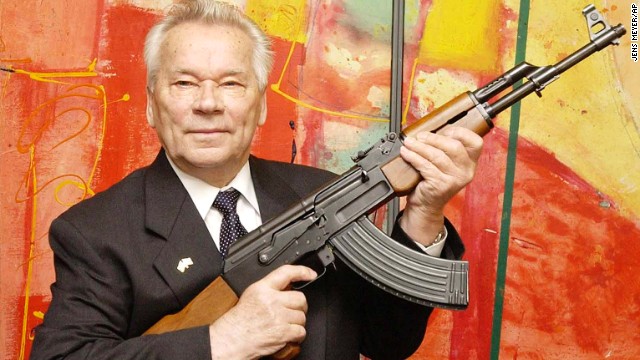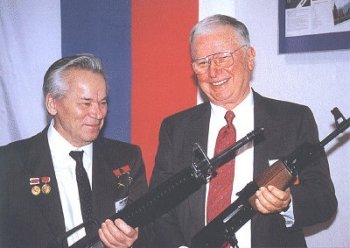Skip to comments.
AK47 assault rifle designer Kalashnikov dies at 94
BBC UK ^
| 12/23/13
Posted on 12/23/2013 10:59:59 PM PST by Impala64ssa
The inventor of the Kalashnikov assault rifle, Mikhail Kalashnikov, has died aged 94, Russian officials say.
The automatic rifle he designed became one of the world's most familiar and widely used weapons.
Its comparative simplicity made it cheap to manufacture, as well as reliable and easy to maintain.
Although honoured by the state, Kalashnikov made little money from his gun. He once said he would have been better off designing a lawn mower.
Kalashnikov was admitted to hospital with internal bleeding in November.
Mikhail Kalashnikov's 1947 design became the standard equipment of the Soviet and Warsaw pact armies. Versions were manufactured in several other countries, including China.
With its distinctive curved magazine, the Kalashnikov became a revolutionary icon in the hands of militants and insurgents around the globe.
When I met him in Paris, he proudly wore the insignia of a Hero of Socialist Labour on his jacket. He seemed perplexed at the extraordinary changes that had engulfed his country.
He was sensitive to any criticism that his gun had caused countless casualties around the world. He told me he had simply designed the rifle to defend the Soviet Union. The uses to which it had been put elsewhere were nothing to do with him, he said.
The Kalashnikov - which is still widely used today - will go down in history. If the name of Samuel Colt and his revolver is associated with the 19th Century, then the gun of the 20th Century is undoubtedly the Kalashnikov.
He died on Monday in Izhevsk, the city where he lived 600 miles east of Moscow, an official there said.
Matching the Germans
Mikhail Timofeyevich Kalashnikov was born on 10 November 1919 in western Siberia, one of 18 children.
In 1938, he was called up by the Red Army
(Excerpt) Read more at bbc.co.uk ...
TOPICS: Foreign Affairs; News/Current Events; Russia
KEYWORDS: banglist
Kalashnikov made little money from his gun.
Gotta love socialism.
To: Impala64ssa
so many in the 20th century.
ruger 10/22
m-16
m-1
mossberg 500
.357 magnum
1911 .45
uzi
thompson machine gun
2
posted on
12/23/2013 11:10:34 PM PST
by
Secret Agent Man
(Gone Galt; Not averse to Going Bronson.)
To: Impala64ssa
3
posted on
12/23/2013 11:15:59 PM PST
by
Liberty Valance
(Keep a simple manner for a happy life :o)
To: Liberty Valance
4
posted on
12/23/2013 11:18:14 PM PST
by
Liberty Valance
(Keep a simple manner for a happy life :o)
To: Impala64ssa
5
posted on
12/23/2013 11:26:45 PM PST
by
Daffynition
(Make Laura Bush's *Cowboy Cookies* for Christmas! They're GREAT!)
To: Impala64ssa
Amazing how those pesky Germans traveled forward in time to steal assault rifles from the soviets.
FWS Forgotten Weapons: The StG44 Assault Rifle

Captured ones were big hits with our troops too:
I remember as a kid watching the old "Combat" TV series with my dad, and always asking questions about the gear, the weapons, etc.
So many interesting tidbits stick in my mind. One was how the actors always had the chinstraps unsnapped and dangling, and that real soldiers never did that, because those little metal hooks would swing up and nail you right in the eye. Soldiers either buckled the snaps under their chin, or around the back of their helmet. I find little details like that fascinating.
He was in the 30th Division that spearheaded most of the big drives in Europe. Wherever the 30th went, the Germans countered with SS Divisions. They fought the 1st and 2nd SS Panzer Divisions in half a dozen big battles. The 17th SS Panzergrenadiers almost as often. I mention that because I once made a snarky comment on the poor Germans being armed with bolt rifles, while the GI's had Garands, BAR's etc. He laughed at that, and said the Germans had damned fine rifles and that GI's often picked them up and used them instead of their own rifles. A few years ago, I researched my dads unit history for a self-published book distributed to the family. I learned that many of the SS units they faced were largely equipped with the G43's by D-Day, and the war went on they were increasingly armed with the STG44. (google these up if you're unfamiliar with them) At Stavelot (the battle of the Bulge) they were up against the the 1st and 2nd SS Panzer Divisions again, and the spearhead units they fought were almost universally armed with the STG44. Even the follow-up SS units had G43's.
The German army had nearly a million g43's and STG44's by the end of the war, and the Waffen SS got first pick of those new rifles
I just find that fascinating. Hollywood would have us believe that the GI's had the Germans outgunned in the small arms arena, but at least where the Waffen SS is concerned that largely isn't true. The GI's were often the ones outgunned, and they still consistently kicked ass.
They really were the greatest generation.
Here's a picture I found of a 30th Division GI in the push to drive the Germans back out of the bulge - note that he is carrying an STG44.
Met a WWII vet at the range Sunday...

6
posted on
12/24/2013 8:50:39 AM PST
by
wizkid
To: wizkid
thanks, for the ping/post. 
7
posted on
12/24/2013 8:55:09 AM PST
by
skinkinthegrass
(The end move in politics is always to pick up a gun..0'Caligula / 0'Reid / 0'Pelosi :-)
To: wizkid
8
posted on
12/24/2013 8:57:16 AM PST
by
nascarnation
(Wish everyone see a "Gay Kwanzaa")
To: nascarnation
General Patton was a stickler for regulation dress so it would surprise me if chin straps were optional in his units even in combat:

I could be wrong though. After searching countless photographs, the preferred method in the European theater appears to be strapping the chin strap to the helmet. Soldiers justified this by saying it protected them from getting their heads ripped off from shell blast concussions. My guess is that they did not like wearing them and used the shell concussion excuse as a pretext.
In any case, here is the first in a great series of documentaries on Patton. It describes how one of his first moves in North Africa was enforcing regulation dress in combat zones including the use of ties by officers
General George S. Patton 360°: Baptism of Blood - S1E3 (part 1/5)
To best answer, how the chin strap was worn, please allow me to defer to more expert replies on this subject:
guardian.co.uk - Chin Strap Question
In all those Hollywood war films, and in quite a few newsreels, the GIs wear helmets but never fasten the straps. Is this bravado, bad discipline or artistic licence?
THIS WAS best answered in the Audie Murphy (most decorated American G.I in World War II ) Biopic "To Hell and Back". Murphy (playing himself in the movie) was told to undo the strap to stop the blast of explosions not only tearing off his helmet but his head along with it. "Well how do I keep it on then?" asks Murphy. "You don't" was the cheerful reply. He then goes on to lose his helmet, win the war and get shot in the backside - which, while painful, certainly took his mind off loosing his hat.
Peter Brooks, Higher Blackley, Manchester (peter.brooks@riva-group.com)
IT IS TRUE that in some cases soldiers really were killed by concussion due to a buckled chinstrap (in the event of an explosion nearby) and for this reason the US Army developed a new chinstrap release, T1, that would allow the chinstrap to unhook under a pressure superior to 15 pounds. This development came in late WWII, too late to help the GIs then, but it was standardised ever since and all helmets refurbished and produced after WWII have (or should have) been fitted with this new device. During the Korean conflict many commanders wanted their soldiers to fasten the chinstrap (as it was meant to be) also because, as an officer [Col. Cawthon] stated, "a soldier wearing a helmet unbuckled looks about as martial as a tomcat with his head in a can of salmon". The T1 fastening hook allowed it to be done without fear of terrible injuries. It must be also noted that a blast near and strong enough to break a neck by concussion will probably cause many other serious injuries. Anyhow, the GIs didn't like to "buckle up" their helmet (M1) at all, fearing a very unlikely injury, and preferred to fasten the chinstrap over the back rim of their steel pot or hook it on the camouflage net, but the helmet was not stable: it wobbled and danced over the head of the running soldier, and (US Army veterans have told me), it was quite usual to see a soldier running with one hand holding his rifle and the other over the helmet. Furthermore, let's face it, a well fastened helmet is not a comfortable thing to wear. The British WWII helmet (MkII) was even less stable than the American helmet (the US Army had a similar shaped helmet until 1941-2) and it had to be worn with its chinstrap under the chin not to fall off immediately when running (but many pictures show soldiers marching or at rest with the strap pulled over the rim, tuched inside the shell or, as also prescribed, worn behind the neck). Its shape was the same of its predecessor, the MkI, which was designed for trench warfare, where soldiers had to be careful about what came right down from the sky - that's why it was wide and flat.
Michele Tagliavini, London N5 (mtag@ndirect.co.uk)
The M1 Helmet in Normandy: A Case Study
If the photo study numbers were hard and fast rules (which they aren’t – just a starting point for proportions and discussion):
Looking at a squad of 12 guys in a reenactment unit – going by the numbers: • 9 of the 12 would have their chinstraps behind the back of the helmet • 1 of the 12 would have their chinstrap buckled under their chin • 1 of the 12 would have their chinstrap up in their helmet net • 1 of the 12 would have their chinstrap dangling down freely
Out of an over strength rifle platoon of 50 of men – going by the numbers • 1 of the 50 would be missing chinstraps entirely missing • 1 or 2 of the 50 would have their chinstrap tucked between their helmet and liner • 36 of the 50 would have their chinstraps behind the back of the helmet • 4 of the 50 would have their chinstrap buckled under their chin • 3 or 4 of the 50 would have their chinstrap up in their helmet net • 4 of the 50 would have their chinstrap dangling down freely
9
posted on
12/24/2013 11:50:20 AM PST
by
wizkid
To: wizkid
Great post, thanks! Merry Christmas.
Have a prosperous 2014 (if that’s possible in the Baraqqi Depression).
10
posted on
12/24/2013 12:19:29 PM PST
by
nascarnation
(Wish everyone see a "Gay Kwanzaa")
Disclaimer:
Opinions posted on Free Republic are those of the individual
posters and do not necessarily represent the opinion of Free Republic or its
management. All materials posted herein are protected by copyright law and the
exemption for fair use of copyrighted works.
FreeRepublic.com is powered by software copyright 2000-2008 John Robinson







